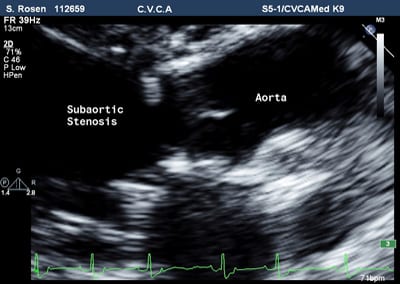Subaortic Stenosis in Dogs
What is Subaortic Stenosis (SAS)?
- A relatively common congenital (inherited) heart defect in the dog and a rare defect in the cat.
- It is most often identified in large and giant breed dogs such as the Newfoundland, Golden Retriever, Boxer, Rottweiler, German Shepherd, English Bulldog, Great Dane, German Short-haired Pointer, and Bouvier des Flandres. It is reported in many other purebreds as well as mixed breeds of dogs.
- It consists of abnormal tissue located just below the aortic valve that creates an obstruction the heart has to overcome to pump blood out to the body.
- Stenosis makes the heart work harder than normal. As a result, the heart muscle can become thickened (hypertrophied). The heart murmur is created by blood being pumped at a higher speed and pressure across the stenosis into the aorta.


Symptoms of SAS may include:
- Lethargy.
- Weakness following exercise or excitement.
- Fainting.
- In some advanced cases, coughing and difficulty breathing secondary to congestive heart failure.
- Dogs with mild SAS may have no clinical signs while moderately to severely affected dogs may be more symptomatic and are at an increased risk of sudden death secondary to arrhythmias.
Diagnosis of SAS
- Echocardiogram with Doppler performed by a board-certified veterinary cardiologist.
- This allows visualization of the four heart chambers and valves as well as the anatomy of the subaortic area. Doppler allows estimation of the pressure created in the heart by the obstruction/stenosis. The degree of pressure elevation correlates with SAS severity.
- An electrocardiogram (ECG) may be required in patients with an irregular heart rhythm.
- A new genetic test is available at the Genetics lab at the N.C State College of Veterinary Medicine Genetics lab that may help screen certain breeds with this disease www.ncstatevets.org/genetics.
How is it treated?
- Prophylactic antibiotics:
- All dogs with SAS are at an increased risk for developing infections of their aortic valve (endocarditis) and should receive antibiotics when they have wounds or are undergoing surgery or dental procedures.
- Limited exercise:
- Leashed walks and short trips to the back yard for dogs with moderate to severe disease.
- Try to avoid vigorous burst type activity
- Cardiac medications:
- Beta-blockers are often recommended for moderate to severely affected SAS dogs.
- Additional therapy to treat specific arrhythmias and heart failure may also be required.
- Surgical and catheterization procedures:
- Available at some university veterinary hospitals; however, they have not yet been shown to improve survival times.
What is the prognosis?
- Mildly affected dogs are expected to have normal life spans will usually remain asymptomatic.
- Severely affected dogs may die suddenly when young to middle-aged.
- It should be noted that SAS can be progressive in some dogs especially in the first few years of life. Thus, even mildly affected, asymptomatic dogs should be periodically reexamined as recommended by your cardiologist or your primary care veterinarian.
